Strategic Leadership: Strategies for Organizational Change Report
VerifiedAdded on 2021/10/28
|16
|3760
|55
Report
AI Summary
This report on strategic leadership comprehensively addresses the challenges of resistance to change within organizations. It begins by identifying the root causes of resistance, such as fear of failure, job security concerns, and technological advancements, providing insights from various case studies. The report then critically analyzes strategies to mitigate resistance, including effective communication, guaranteeing against loss, and building trust. Furthermore, it outlines methods to model professionally, ethically, socially, and culturally appropriate behaviors, emphasizing the importance of workshops, ethical standards, CSR activities, and cultural awareness. Finally, the report explores intellectual stimulation, individualized consideration, inspirational motivation, and perseverance through conflict as key aspects of transformational leadership, identifying practices to improve employee productivity and engagement during transitional change. The report is a detailed exploration of leadership, organizational change, and ethical conduct.
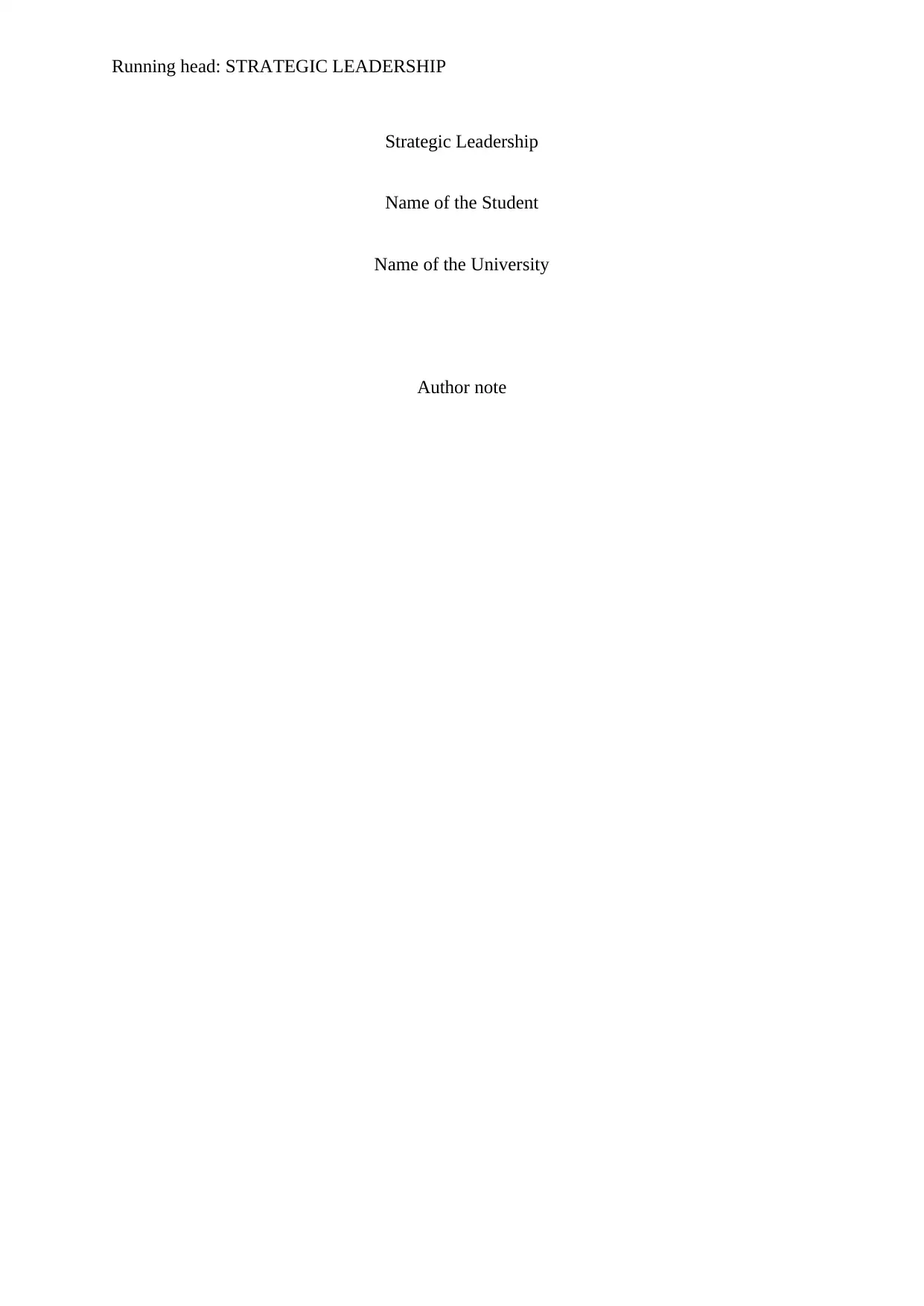
Running head: STRATEGIC LEADERSHIP
Strategic Leadership
Name of the Student
Name of the University
Author note
Strategic Leadership
Name of the Student
Name of the University
Author note
Paraphrase This Document
Need a fresh take? Get an instant paraphrase of this document with our AI Paraphraser
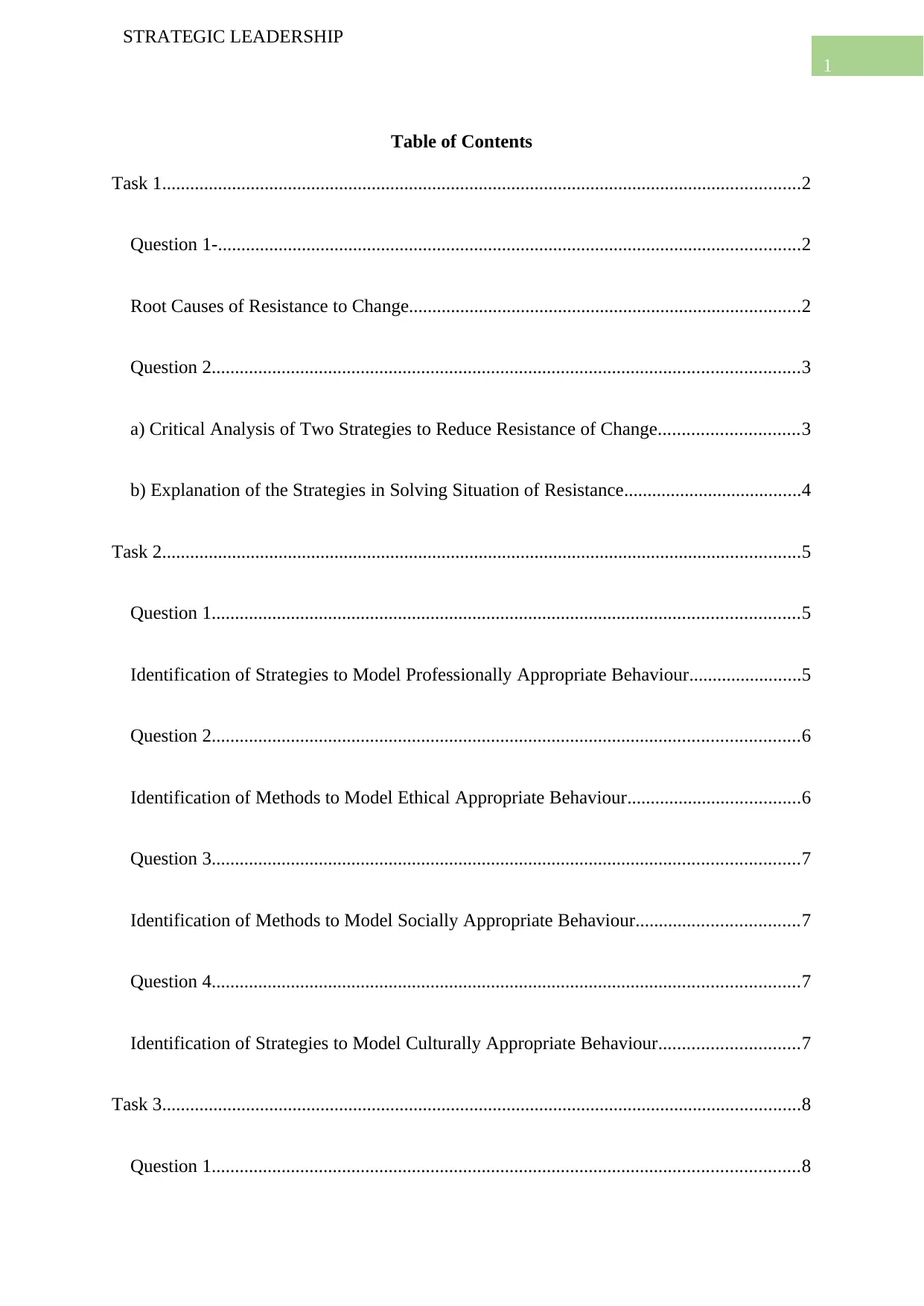
1
STRATEGIC LEADERSHIP
Table of Contents
Task 1.........................................................................................................................................2
Question 1-.............................................................................................................................2
Root Causes of Resistance to Change....................................................................................2
Question 2..............................................................................................................................3
a) Critical Analysis of Two Strategies to Reduce Resistance of Change..............................3
b) Explanation of the Strategies in Solving Situation of Resistance......................................4
Task 2.........................................................................................................................................5
Question 1..............................................................................................................................5
Identification of Strategies to Model Professionally Appropriate Behaviour........................5
Question 2..............................................................................................................................6
Identification of Methods to Model Ethical Appropriate Behaviour.....................................6
Question 3..............................................................................................................................7
Identification of Methods to Model Socially Appropriate Behaviour...................................7
Question 4..............................................................................................................................7
Identification of Strategies to Model Culturally Appropriate Behaviour..............................7
Task 3.........................................................................................................................................8
Question 1..............................................................................................................................8
STRATEGIC LEADERSHIP
Table of Contents
Task 1.........................................................................................................................................2
Question 1-.............................................................................................................................2
Root Causes of Resistance to Change....................................................................................2
Question 2..............................................................................................................................3
a) Critical Analysis of Two Strategies to Reduce Resistance of Change..............................3
b) Explanation of the Strategies in Solving Situation of Resistance......................................4
Task 2.........................................................................................................................................5
Question 1..............................................................................................................................5
Identification of Strategies to Model Professionally Appropriate Behaviour........................5
Question 2..............................................................................................................................6
Identification of Methods to Model Ethical Appropriate Behaviour.....................................6
Question 3..............................................................................................................................7
Identification of Methods to Model Socially Appropriate Behaviour...................................7
Question 4..............................................................................................................................7
Identification of Strategies to Model Culturally Appropriate Behaviour..............................7
Task 3.........................................................................................................................................8
Question 1..............................................................................................................................8
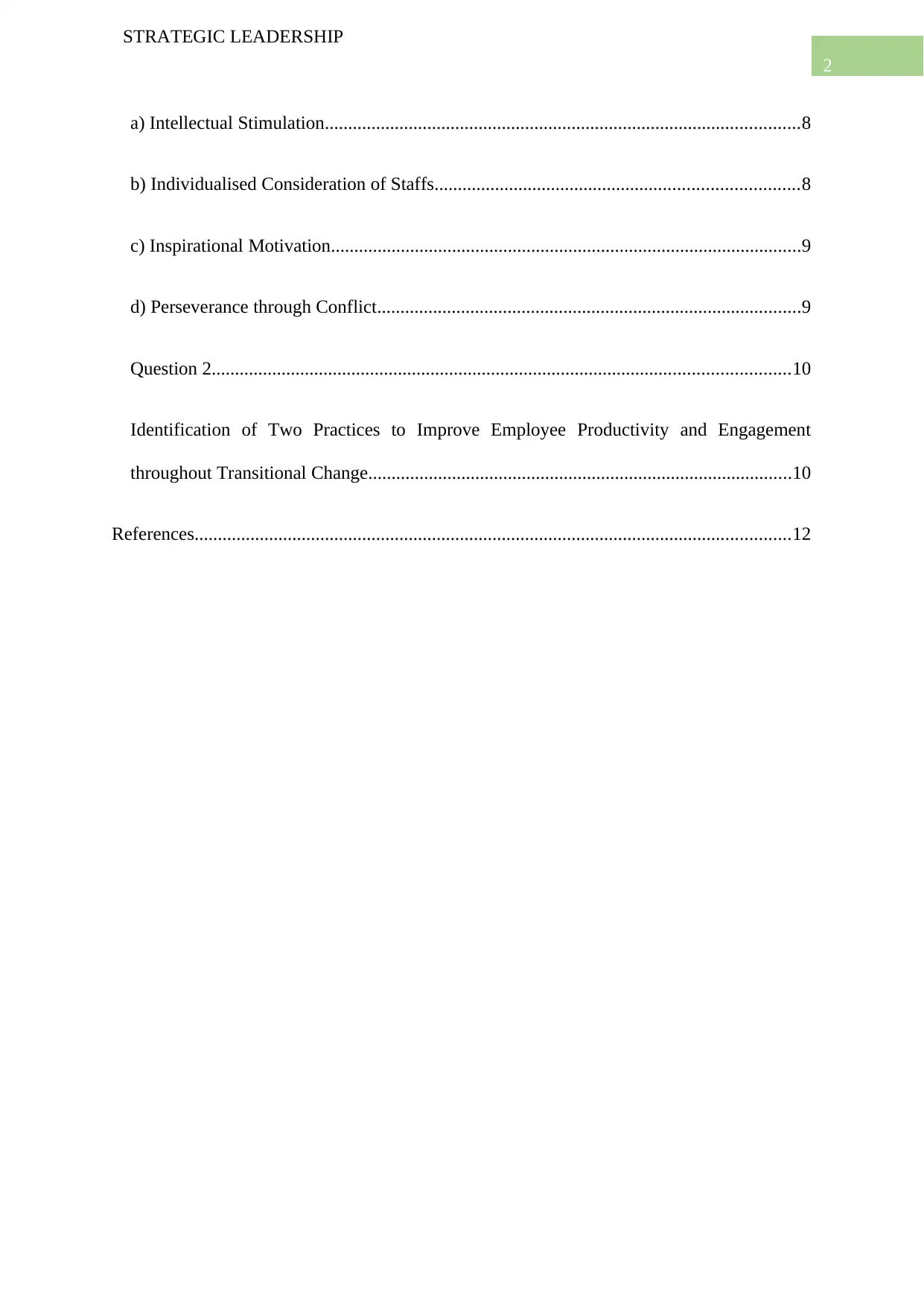
2
STRATEGIC LEADERSHIP
a) Intellectual Stimulation......................................................................................................8
b) Individualised Consideration of Staffs..............................................................................8
c) Inspirational Motivation.....................................................................................................9
d) Perseverance through Conflict...........................................................................................9
Question 2............................................................................................................................10
Identification of Two Practices to Improve Employee Productivity and Engagement
throughout Transitional Change...........................................................................................10
References................................................................................................................................12
STRATEGIC LEADERSHIP
a) Intellectual Stimulation......................................................................................................8
b) Individualised Consideration of Staffs..............................................................................8
c) Inspirational Motivation.....................................................................................................9
d) Perseverance through Conflict...........................................................................................9
Question 2............................................................................................................................10
Identification of Two Practices to Improve Employee Productivity and Engagement
throughout Transitional Change...........................................................................................10
References................................................................................................................................12
⊘ This is a preview!⊘
Do you want full access?
Subscribe today to unlock all pages.

Trusted by 1+ million students worldwide
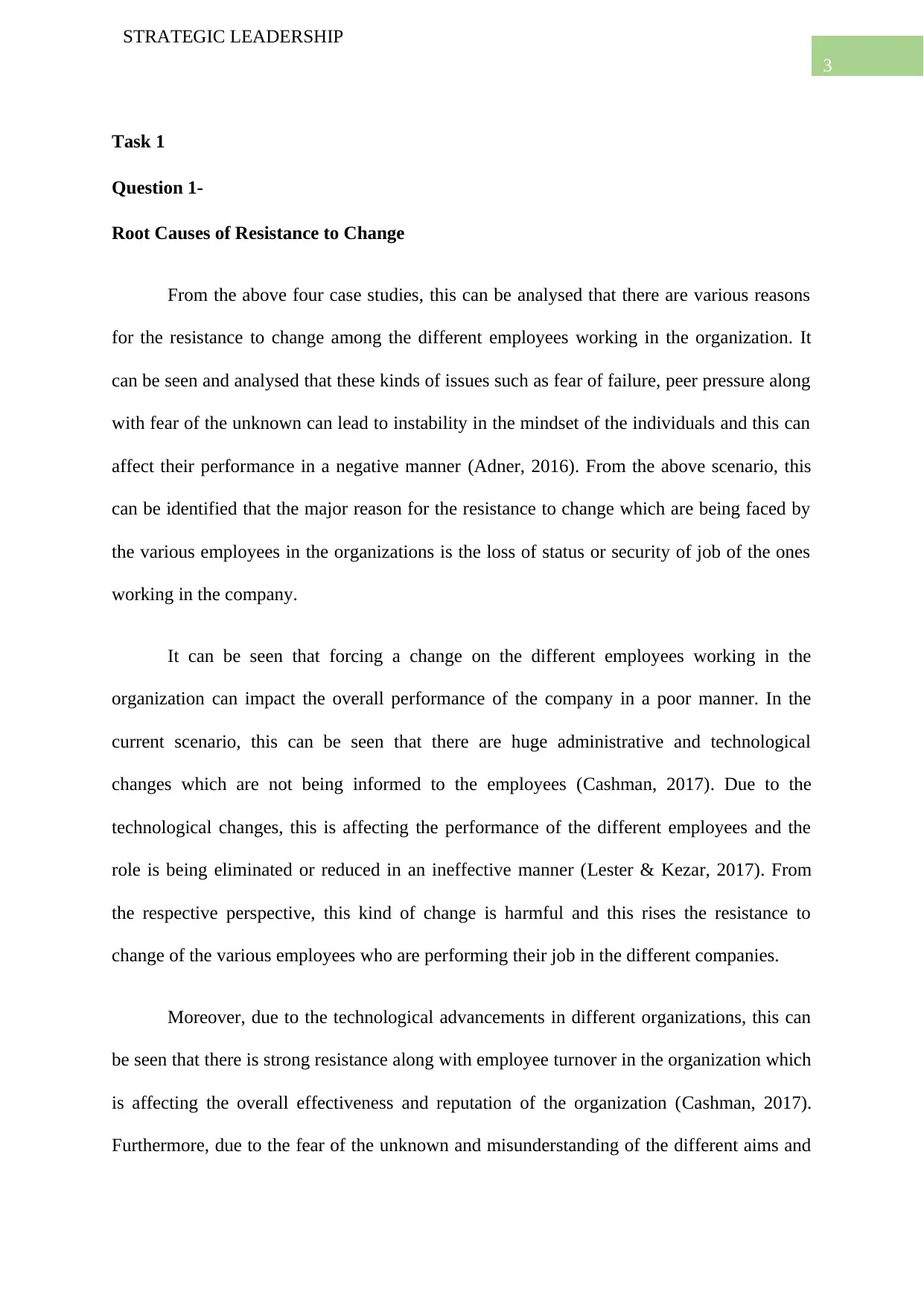
3
STRATEGIC LEADERSHIP
Task 1
Question 1-
Root Causes of Resistance to Change
From the above four case studies, this can be analysed that there are various reasons
for the resistance to change among the different employees working in the organization. It
can be seen and analysed that these kinds of issues such as fear of failure, peer pressure along
with fear of the unknown can lead to instability in the mindset of the individuals and this can
affect their performance in a negative manner (Adner, 2016). From the above scenario, this
can be identified that the major reason for the resistance to change which are being faced by
the various employees in the organizations is the loss of status or security of job of the ones
working in the company.
It can be seen that forcing a change on the different employees working in the
organization can impact the overall performance of the company in a poor manner. In the
current scenario, this can be seen that there are huge administrative and technological
changes which are not being informed to the employees (Cashman, 2017). Due to the
technological changes, this is affecting the performance of the different employees and the
role is being eliminated or reduced in an ineffective manner (Lester & Kezar, 2017). From
the respective perspective, this kind of change is harmful and this rises the resistance to
change of the various employees who are performing their job in the different companies.
Moreover, due to the technological advancements in different organizations, this can
be seen that there is strong resistance along with employee turnover in the organization which
is affecting the overall effectiveness and reputation of the organization (Cashman, 2017).
Furthermore, due to the fear of the unknown and misunderstanding of the different aims and
STRATEGIC LEADERSHIP
Task 1
Question 1-
Root Causes of Resistance to Change
From the above four case studies, this can be analysed that there are various reasons
for the resistance to change among the different employees working in the organization. It
can be seen and analysed that these kinds of issues such as fear of failure, peer pressure along
with fear of the unknown can lead to instability in the mindset of the individuals and this can
affect their performance in a negative manner (Adner, 2016). From the above scenario, this
can be identified that the major reason for the resistance to change which are being faced by
the various employees in the organizations is the loss of status or security of job of the ones
working in the company.
It can be seen that forcing a change on the different employees working in the
organization can impact the overall performance of the company in a poor manner. In the
current scenario, this can be seen that there are huge administrative and technological
changes which are not being informed to the employees (Cashman, 2017). Due to the
technological changes, this is affecting the performance of the different employees and the
role is being eliminated or reduced in an ineffective manner (Lester & Kezar, 2017). From
the respective perspective, this kind of change is harmful and this rises the resistance to
change of the various employees who are performing their job in the different companies.
Moreover, due to the technological advancements in different organizations, this can
be seen that there is strong resistance along with employee turnover in the organization which
is affecting the overall effectiveness and reputation of the organization (Cashman, 2017).
Furthermore, due to the fear of the unknown and misunderstanding of the different aims and
Paraphrase This Document
Need a fresh take? Get an instant paraphrase of this document with our AI Paraphraser
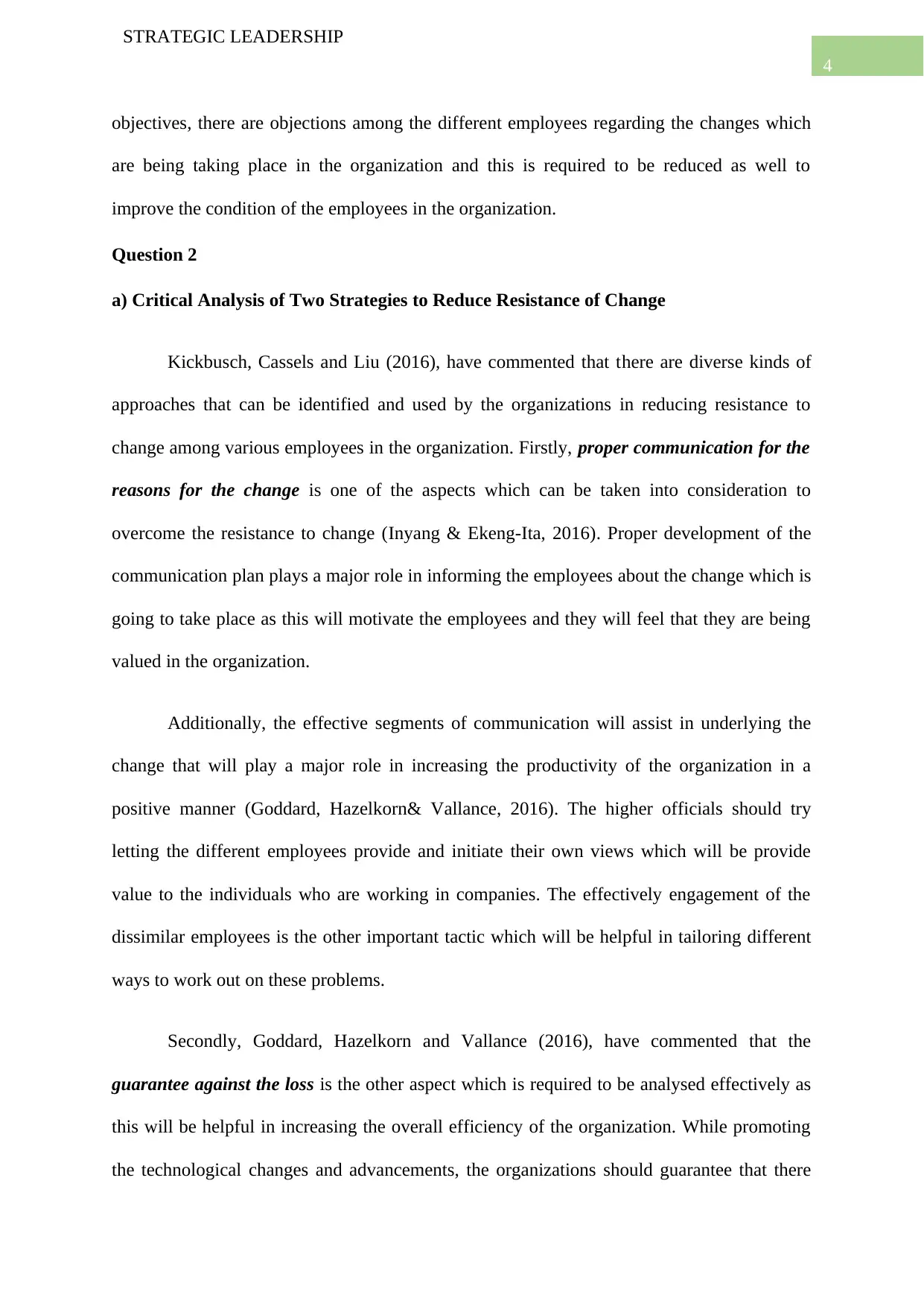
4
STRATEGIC LEADERSHIP
objectives, there are objections among the different employees regarding the changes which
are being taking place in the organization and this is required to be reduced as well to
improve the condition of the employees in the organization.
Question 2
a) Critical Analysis of Two Strategies to Reduce Resistance of Change
Kickbusch, Cassels and Liu (2016), have commented that there are diverse kinds of
approaches that can be identified and used by the organizations in reducing resistance to
change among various employees in the organization. Firstly, proper communication for the
reasons for the change is one of the aspects which can be taken into consideration to
overcome the resistance to change (Inyang & Ekeng-Ita, 2016). Proper development of the
communication plan plays a major role in informing the employees about the change which is
going to take place as this will motivate the employees and they will feel that they are being
valued in the organization.
Additionally, the effective segments of communication will assist in underlying the
change that will play a major role in increasing the productivity of the organization in a
positive manner (Goddard, Hazelkorn& Vallance, 2016). The higher officials should try
letting the different employees provide and initiate their own views which will be provide
value to the individuals who are working in companies. The effectively engagement of the
dissimilar employees is the other important tactic which will be helpful in tailoring different
ways to work out on these problems.
Secondly, Goddard, Hazelkorn and Vallance (2016), have commented that the
guarantee against the loss is the other aspect which is required to be analysed effectively as
this will be helpful in increasing the overall efficiency of the organization. While promoting
the technological changes and advancements, the organizations should guarantee that there
STRATEGIC LEADERSHIP
objectives, there are objections among the different employees regarding the changes which
are being taking place in the organization and this is required to be reduced as well to
improve the condition of the employees in the organization.
Question 2
a) Critical Analysis of Two Strategies to Reduce Resistance of Change
Kickbusch, Cassels and Liu (2016), have commented that there are diverse kinds of
approaches that can be identified and used by the organizations in reducing resistance to
change among various employees in the organization. Firstly, proper communication for the
reasons for the change is one of the aspects which can be taken into consideration to
overcome the resistance to change (Inyang & Ekeng-Ita, 2016). Proper development of the
communication plan plays a major role in informing the employees about the change which is
going to take place as this will motivate the employees and they will feel that they are being
valued in the organization.
Additionally, the effective segments of communication will assist in underlying the
change that will play a major role in increasing the productivity of the organization in a
positive manner (Goddard, Hazelkorn& Vallance, 2016). The higher officials should try
letting the different employees provide and initiate their own views which will be provide
value to the individuals who are working in companies. The effectively engagement of the
dissimilar employees is the other important tactic which will be helpful in tailoring different
ways to work out on these problems.
Secondly, Goddard, Hazelkorn and Vallance (2016), have commented that the
guarantee against the loss is the other aspect which is required to be analysed effectively as
this will be helpful in increasing the overall efficiency of the organization. While promoting
the technological changes and advancements, the organizations should guarantee that there
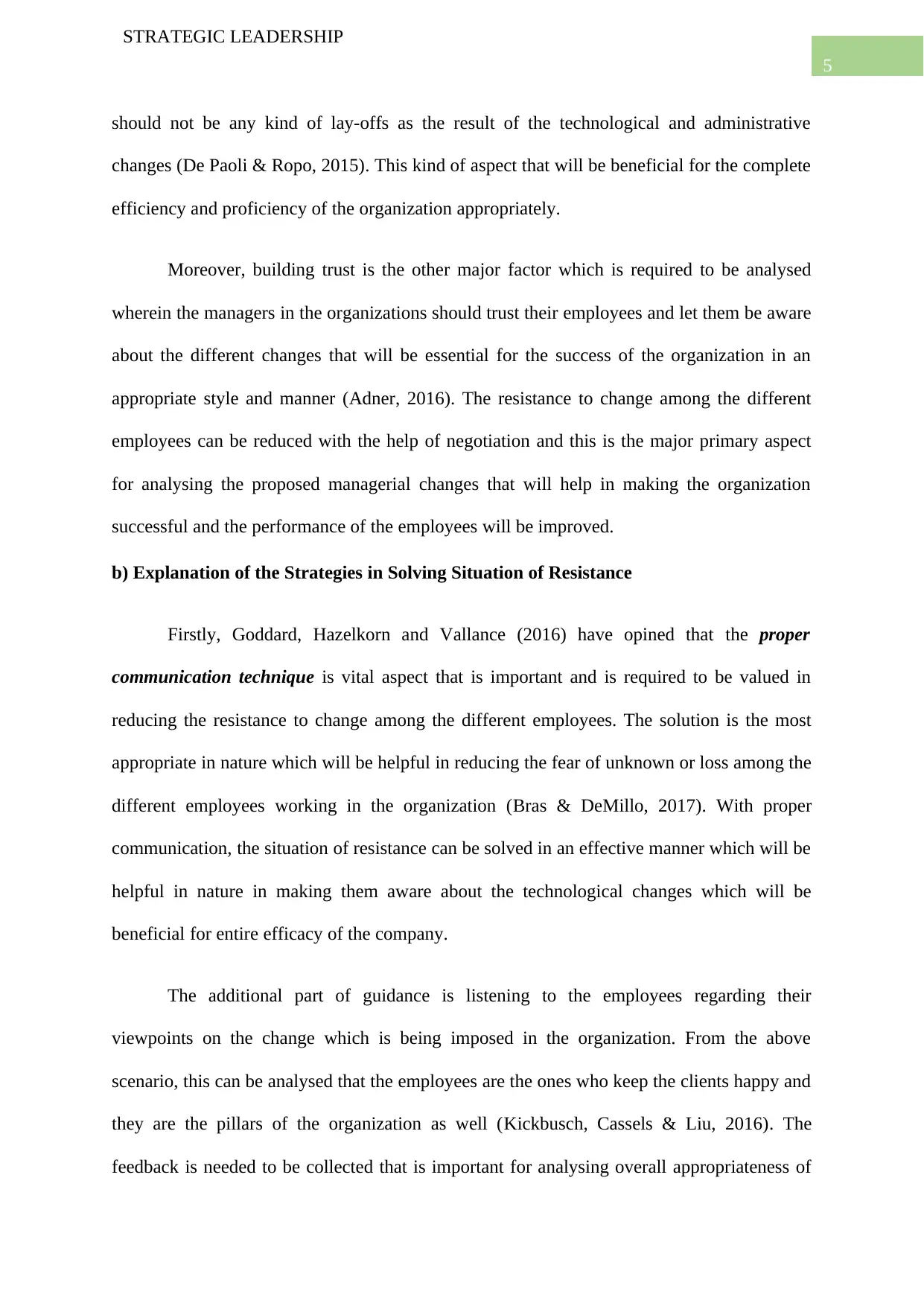
5
STRATEGIC LEADERSHIP
should not be any kind of lay-offs as the result of the technological and administrative
changes (De Paoli & Ropo, 2015). This kind of aspect that will be beneficial for the complete
efficiency and proficiency of the organization appropriately.
Moreover, building trust is the other major factor which is required to be analysed
wherein the managers in the organizations should trust their employees and let them be aware
about the different changes that will be essential for the success of the organization in an
appropriate style and manner (Adner, 2016). The resistance to change among the different
employees can be reduced with the help of negotiation and this is the major primary aspect
for analysing the proposed managerial changes that will help in making the organization
successful and the performance of the employees will be improved.
b) Explanation of the Strategies in Solving Situation of Resistance
Firstly, Goddard, Hazelkorn and Vallance (2016) have opined that the proper
communication technique is vital aspect that is important and is required to be valued in
reducing the resistance to change among the different employees. The solution is the most
appropriate in nature which will be helpful in reducing the fear of unknown or loss among the
different employees working in the organization (Bras & DeMillo, 2017). With proper
communication, the situation of resistance can be solved in an effective manner which will be
helpful in nature in making them aware about the technological changes which will be
beneficial for entire efficacy of the company.
The additional part of guidance is listening to the employees regarding their
viewpoints on the change which is being imposed in the organization. From the above
scenario, this can be analysed that the employees are the ones who keep the clients happy and
they are the pillars of the organization as well (Kickbusch, Cassels & Liu, 2016). The
feedback is needed to be collected that is important for analysing overall appropriateness of
STRATEGIC LEADERSHIP
should not be any kind of lay-offs as the result of the technological and administrative
changes (De Paoli & Ropo, 2015). This kind of aspect that will be beneficial for the complete
efficiency and proficiency of the organization appropriately.
Moreover, building trust is the other major factor which is required to be analysed
wherein the managers in the organizations should trust their employees and let them be aware
about the different changes that will be essential for the success of the organization in an
appropriate style and manner (Adner, 2016). The resistance to change among the different
employees can be reduced with the help of negotiation and this is the major primary aspect
for analysing the proposed managerial changes that will help in making the organization
successful and the performance of the employees will be improved.
b) Explanation of the Strategies in Solving Situation of Resistance
Firstly, Goddard, Hazelkorn and Vallance (2016) have opined that the proper
communication technique is vital aspect that is important and is required to be valued in
reducing the resistance to change among the different employees. The solution is the most
appropriate in nature which will be helpful in reducing the fear of unknown or loss among the
different employees working in the organization (Bras & DeMillo, 2017). With proper
communication, the situation of resistance can be solved in an effective manner which will be
helpful in nature in making them aware about the technological changes which will be
beneficial for entire efficacy of the company.
The additional part of guidance is listening to the employees regarding their
viewpoints on the change which is being imposed in the organization. From the above
scenario, this can be analysed that the employees are the ones who keep the clients happy and
they are the pillars of the organization as well (Kickbusch, Cassels & Liu, 2016). The
feedback is needed to be collected that is important for analysing overall appropriateness of
⊘ This is a preview!⊘
Do you want full access?
Subscribe today to unlock all pages.

Trusted by 1+ million students worldwide
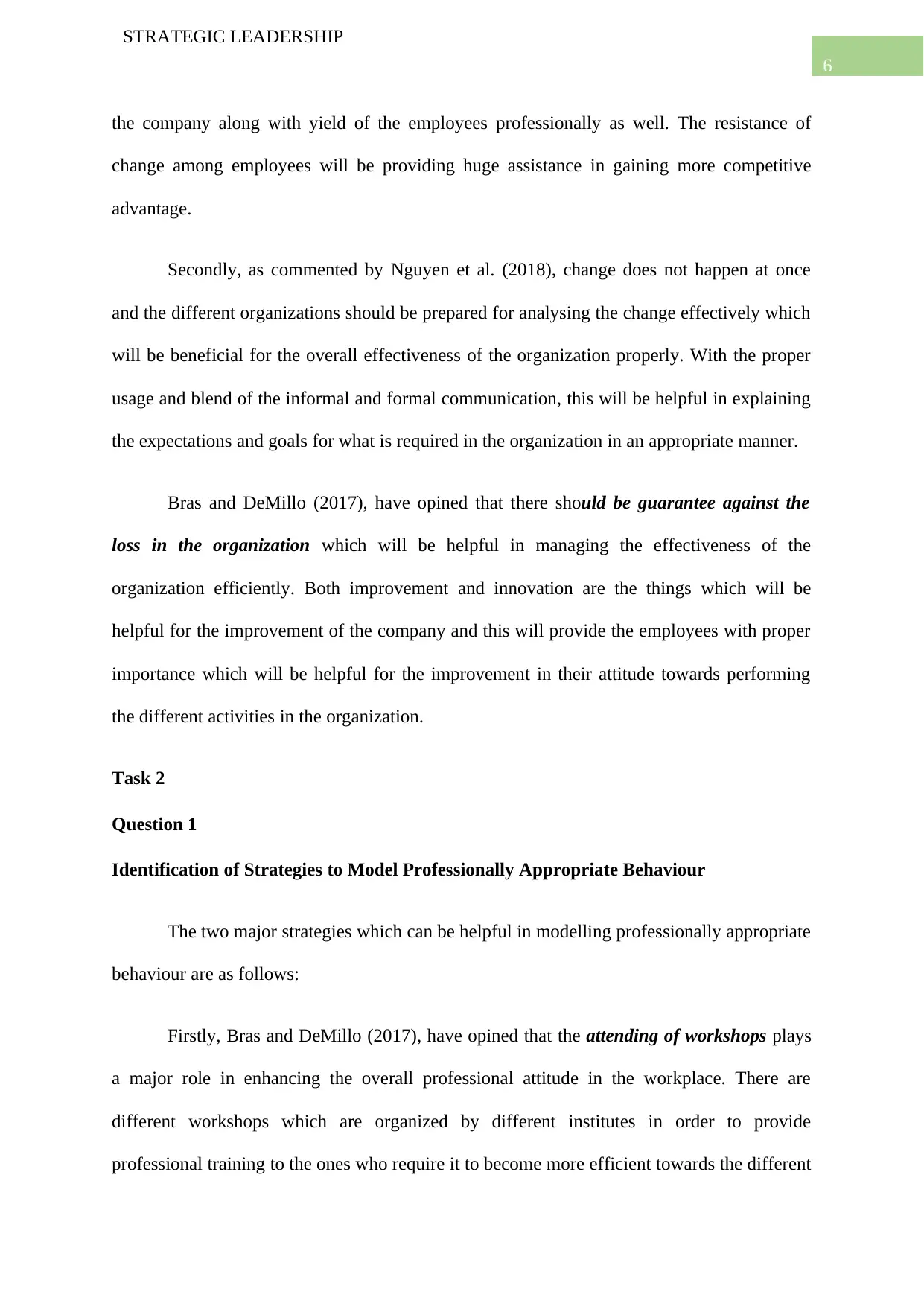
6
STRATEGIC LEADERSHIP
the company along with yield of the employees professionally as well. The resistance of
change among employees will be providing huge assistance in gaining more competitive
advantage.
Secondly, as commented by Nguyen et al. (2018), change does not happen at once
and the different organizations should be prepared for analysing the change effectively which
will be beneficial for the overall effectiveness of the organization properly. With the proper
usage and blend of the informal and formal communication, this will be helpful in explaining
the expectations and goals for what is required in the organization in an appropriate manner.
Bras and DeMillo (2017), have opined that there should be guarantee against the
loss in the organization which will be helpful in managing the effectiveness of the
organization efficiently. Both improvement and innovation are the things which will be
helpful for the improvement of the company and this will provide the employees with proper
importance which will be helpful for the improvement in their attitude towards performing
the different activities in the organization.
Task 2
Question 1
Identification of Strategies to Model Professionally Appropriate Behaviour
The two major strategies which can be helpful in modelling professionally appropriate
behaviour are as follows:
Firstly, Bras and DeMillo (2017), have opined that the attending of workshops plays
a major role in enhancing the overall professional attitude in the workplace. There are
different workshops which are organized by different institutes in order to provide
professional training to the ones who require it to become more efficient towards the different
STRATEGIC LEADERSHIP
the company along with yield of the employees professionally as well. The resistance of
change among employees will be providing huge assistance in gaining more competitive
advantage.
Secondly, as commented by Nguyen et al. (2018), change does not happen at once
and the different organizations should be prepared for analysing the change effectively which
will be beneficial for the overall effectiveness of the organization properly. With the proper
usage and blend of the informal and formal communication, this will be helpful in explaining
the expectations and goals for what is required in the organization in an appropriate manner.
Bras and DeMillo (2017), have opined that there should be guarantee against the
loss in the organization which will be helpful in managing the effectiveness of the
organization efficiently. Both improvement and innovation are the things which will be
helpful for the improvement of the company and this will provide the employees with proper
importance which will be helpful for the improvement in their attitude towards performing
the different activities in the organization.
Task 2
Question 1
Identification of Strategies to Model Professionally Appropriate Behaviour
The two major strategies which can be helpful in modelling professionally appropriate
behaviour are as follows:
Firstly, Bras and DeMillo (2017), have opined that the attending of workshops plays
a major role in enhancing the overall professional attitude in the workplace. There are
different workshops which are organized by different institutes in order to provide
professional training to the ones who require it to become more efficient towards the different
Paraphrase This Document
Need a fresh take? Get an instant paraphrase of this document with our AI Paraphraser
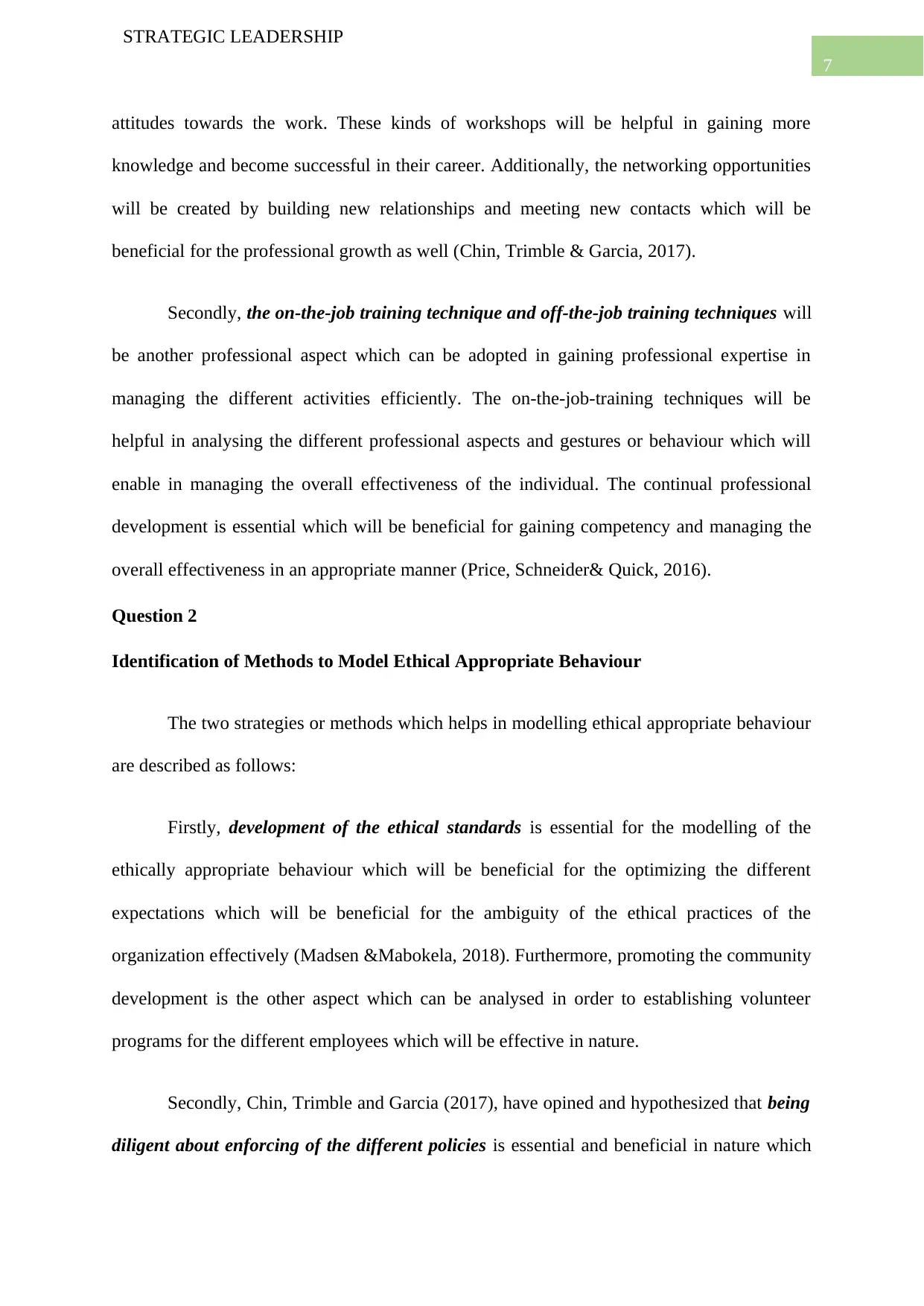
7
STRATEGIC LEADERSHIP
attitudes towards the work. These kinds of workshops will be helpful in gaining more
knowledge and become successful in their career. Additionally, the networking opportunities
will be created by building new relationships and meeting new contacts which will be
beneficial for the professional growth as well (Chin, Trimble & Garcia, 2017).
Secondly, the on-the-job training technique and off-the-job training techniques will
be another professional aspect which can be adopted in gaining professional expertise in
managing the different activities efficiently. The on-the-job-training techniques will be
helpful in analysing the different professional aspects and gestures or behaviour which will
enable in managing the overall effectiveness of the individual. The continual professional
development is essential which will be beneficial for gaining competency and managing the
overall effectiveness in an appropriate manner (Price, Schneider& Quick, 2016).
Question 2
Identification of Methods to Model Ethical Appropriate Behaviour
The two strategies or methods which helps in modelling ethical appropriate behaviour
are described as follows:
Firstly, development of the ethical standards is essential for the modelling of the
ethically appropriate behaviour which will be beneficial for the optimizing the different
expectations which will be beneficial for the ambiguity of the ethical practices of the
organization effectively (Madsen &Mabokela, 2018). Furthermore, promoting the community
development is the other aspect which can be analysed in order to establishing volunteer
programs for the different employees which will be effective in nature.
Secondly, Chin, Trimble and Garcia (2017), have opined and hypothesized that being
diligent about enforcing of the different policies is essential and beneficial in nature which
STRATEGIC LEADERSHIP
attitudes towards the work. These kinds of workshops will be helpful in gaining more
knowledge and become successful in their career. Additionally, the networking opportunities
will be created by building new relationships and meeting new contacts which will be
beneficial for the professional growth as well (Chin, Trimble & Garcia, 2017).
Secondly, the on-the-job training technique and off-the-job training techniques will
be another professional aspect which can be adopted in gaining professional expertise in
managing the different activities efficiently. The on-the-job-training techniques will be
helpful in analysing the different professional aspects and gestures or behaviour which will
enable in managing the overall effectiveness of the individual. The continual professional
development is essential which will be beneficial for gaining competency and managing the
overall effectiveness in an appropriate manner (Price, Schneider& Quick, 2016).
Question 2
Identification of Methods to Model Ethical Appropriate Behaviour
The two strategies or methods which helps in modelling ethical appropriate behaviour
are described as follows:
Firstly, development of the ethical standards is essential for the modelling of the
ethically appropriate behaviour which will be beneficial for the optimizing the different
expectations which will be beneficial for the ambiguity of the ethical practices of the
organization effectively (Madsen &Mabokela, 2018). Furthermore, promoting the community
development is the other aspect which can be analysed in order to establishing volunteer
programs for the different employees which will be effective in nature.
Secondly, Chin, Trimble and Garcia (2017), have opined and hypothesized that being
diligent about enforcing of the different policies is essential and beneficial in nature which
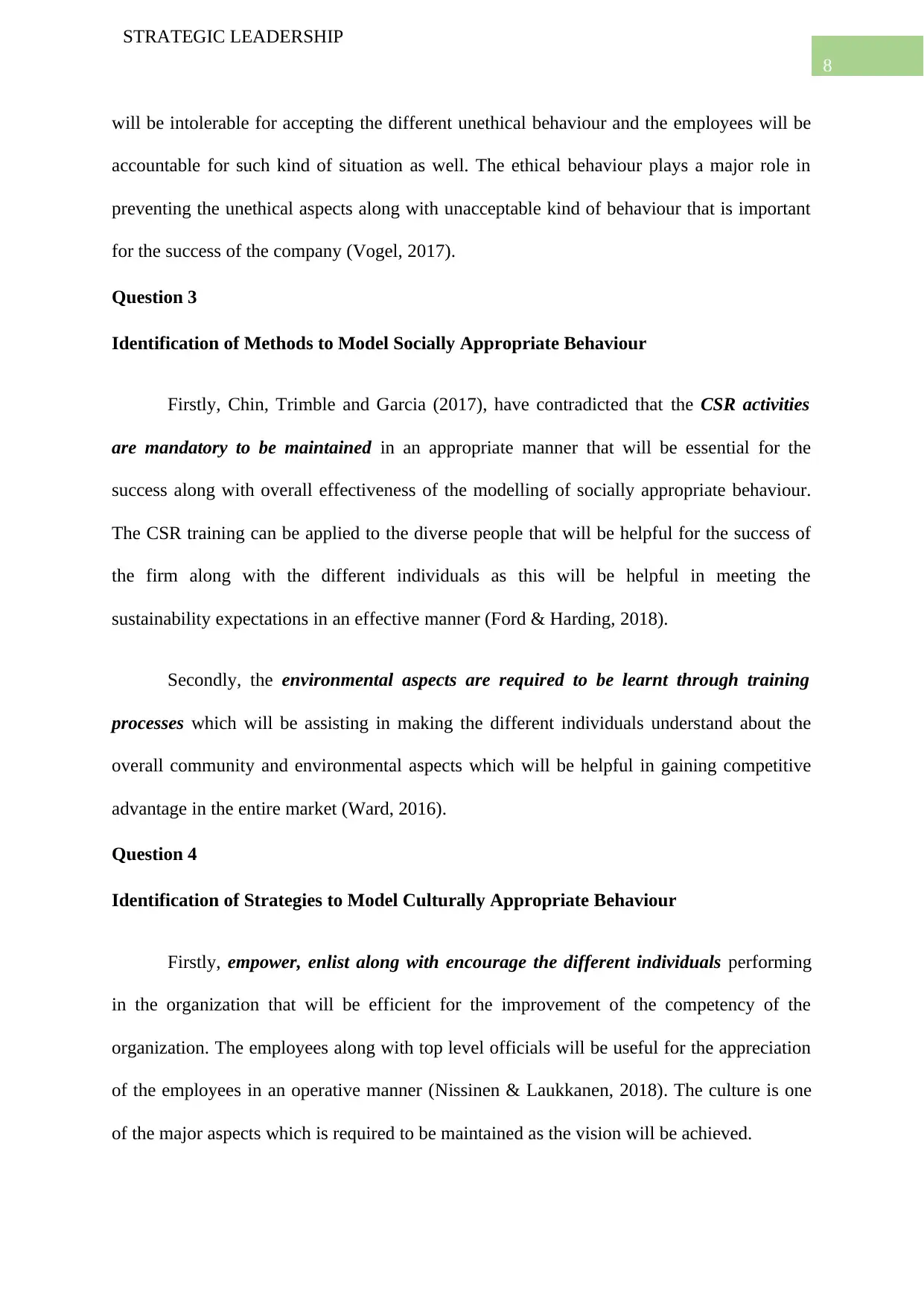
8
STRATEGIC LEADERSHIP
will be intolerable for accepting the different unethical behaviour and the employees will be
accountable for such kind of situation as well. The ethical behaviour plays a major role in
preventing the unethical aspects along with unacceptable kind of behaviour that is important
for the success of the company (Vogel, 2017).
Question 3
Identification of Methods to Model Socially Appropriate Behaviour
Firstly, Chin, Trimble and Garcia (2017), have contradicted that the CSR activities
are mandatory to be maintained in an appropriate manner that will be essential for the
success along with overall effectiveness of the modelling of socially appropriate behaviour.
The CSR training can be applied to the diverse people that will be helpful for the success of
the firm along with the different individuals as this will be helpful in meeting the
sustainability expectations in an effective manner (Ford & Harding, 2018).
Secondly, the environmental aspects are required to be learnt through training
processes which will be assisting in making the different individuals understand about the
overall community and environmental aspects which will be helpful in gaining competitive
advantage in the entire market (Ward, 2016).
Question 4
Identification of Strategies to Model Culturally Appropriate Behaviour
Firstly, empower, enlist along with encourage the different individuals performing
in the organization that will be efficient for the improvement of the competency of the
organization. The employees along with top level officials will be useful for the appreciation
of the employees in an operative manner (Nissinen & Laukkanen, 2018). The culture is one
of the major aspects which is required to be maintained as the vision will be achieved.
STRATEGIC LEADERSHIP
will be intolerable for accepting the different unethical behaviour and the employees will be
accountable for such kind of situation as well. The ethical behaviour plays a major role in
preventing the unethical aspects along with unacceptable kind of behaviour that is important
for the success of the company (Vogel, 2017).
Question 3
Identification of Methods to Model Socially Appropriate Behaviour
Firstly, Chin, Trimble and Garcia (2017), have contradicted that the CSR activities
are mandatory to be maintained in an appropriate manner that will be essential for the
success along with overall effectiveness of the modelling of socially appropriate behaviour.
The CSR training can be applied to the diverse people that will be helpful for the success of
the firm along with the different individuals as this will be helpful in meeting the
sustainability expectations in an effective manner (Ford & Harding, 2018).
Secondly, the environmental aspects are required to be learnt through training
processes which will be assisting in making the different individuals understand about the
overall community and environmental aspects which will be helpful in gaining competitive
advantage in the entire market (Ward, 2016).
Question 4
Identification of Strategies to Model Culturally Appropriate Behaviour
Firstly, empower, enlist along with encourage the different individuals performing
in the organization that will be efficient for the improvement of the competency of the
organization. The employees along with top level officials will be useful for the appreciation
of the employees in an operative manner (Nissinen & Laukkanen, 2018). The culture is one
of the major aspects which is required to be maintained as the vision will be achieved.
⊘ This is a preview!⊘
Do you want full access?
Subscribe today to unlock all pages.

Trusted by 1+ million students worldwide
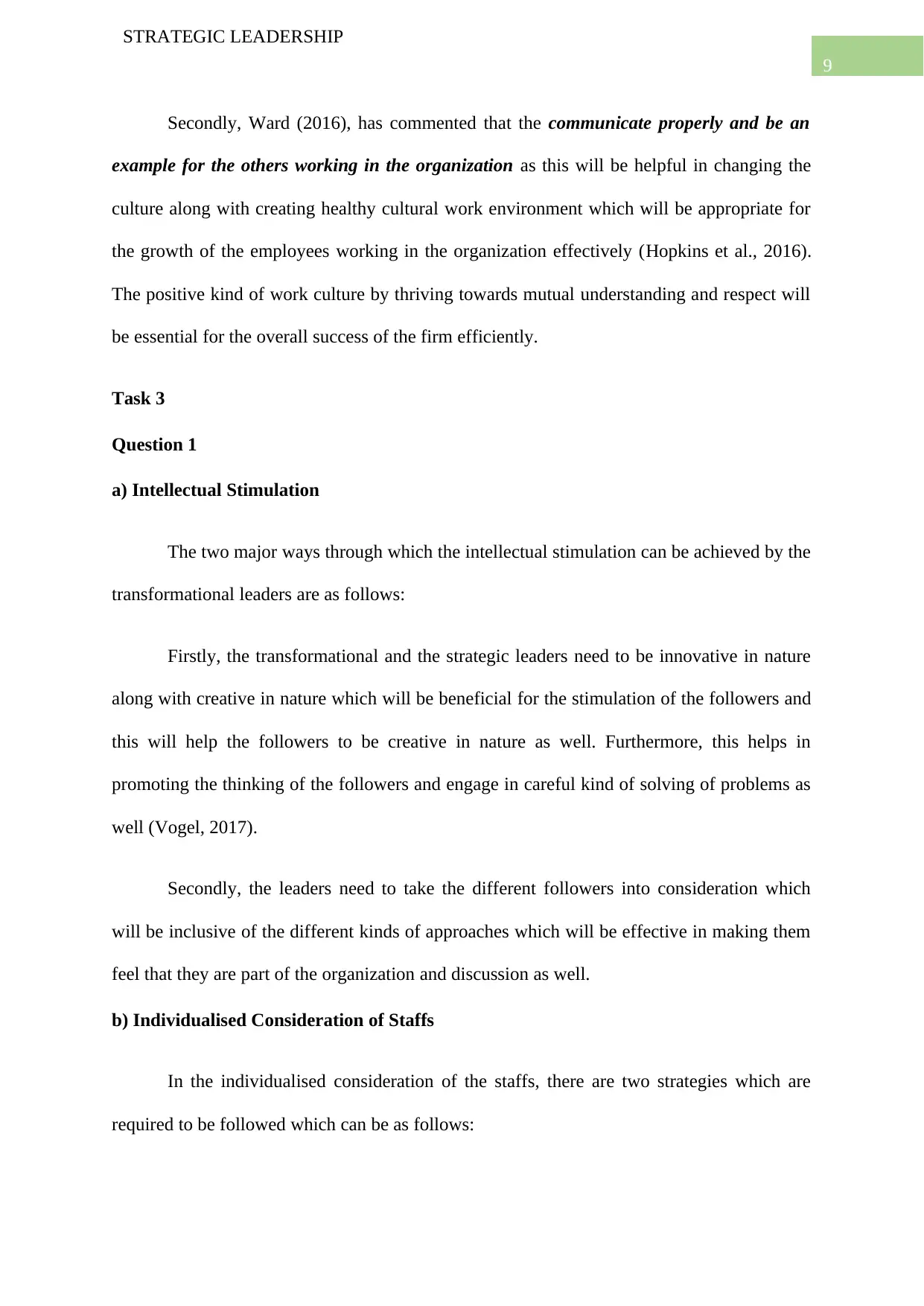
9
STRATEGIC LEADERSHIP
Secondly, Ward (2016), has commented that the communicate properly and be an
example for the others working in the organization as this will be helpful in changing the
culture along with creating healthy cultural work environment which will be appropriate for
the growth of the employees working in the organization effectively (Hopkins et al., 2016).
The positive kind of work culture by thriving towards mutual understanding and respect will
be essential for the overall success of the firm efficiently.
Task 3
Question 1
a) Intellectual Stimulation
The two major ways through which the intellectual stimulation can be achieved by the
transformational leaders are as follows:
Firstly, the transformational and the strategic leaders need to be innovative in nature
along with creative in nature which will be beneficial for the stimulation of the followers and
this will help the followers to be creative in nature as well. Furthermore, this helps in
promoting the thinking of the followers and engage in careful kind of solving of problems as
well (Vogel, 2017).
Secondly, the leaders need to take the different followers into consideration which
will be inclusive of the different kinds of approaches which will be effective in making them
feel that they are part of the organization and discussion as well.
b) Individualised Consideration of Staffs
In the individualised consideration of the staffs, there are two strategies which are
required to be followed which can be as follows:
STRATEGIC LEADERSHIP
Secondly, Ward (2016), has commented that the communicate properly and be an
example for the others working in the organization as this will be helpful in changing the
culture along with creating healthy cultural work environment which will be appropriate for
the growth of the employees working in the organization effectively (Hopkins et al., 2016).
The positive kind of work culture by thriving towards mutual understanding and respect will
be essential for the overall success of the firm efficiently.
Task 3
Question 1
a) Intellectual Stimulation
The two major ways through which the intellectual stimulation can be achieved by the
transformational leaders are as follows:
Firstly, the transformational and the strategic leaders need to be innovative in nature
along with creative in nature which will be beneficial for the stimulation of the followers and
this will help the followers to be creative in nature as well. Furthermore, this helps in
promoting the thinking of the followers and engage in careful kind of solving of problems as
well (Vogel, 2017).
Secondly, the leaders need to take the different followers into consideration which
will be inclusive of the different kinds of approaches which will be effective in making them
feel that they are part of the organization and discussion as well.
b) Individualised Consideration of Staffs
In the individualised consideration of the staffs, there are two strategies which are
required to be followed which can be as follows:
Paraphrase This Document
Need a fresh take? Get an instant paraphrase of this document with our AI Paraphraser
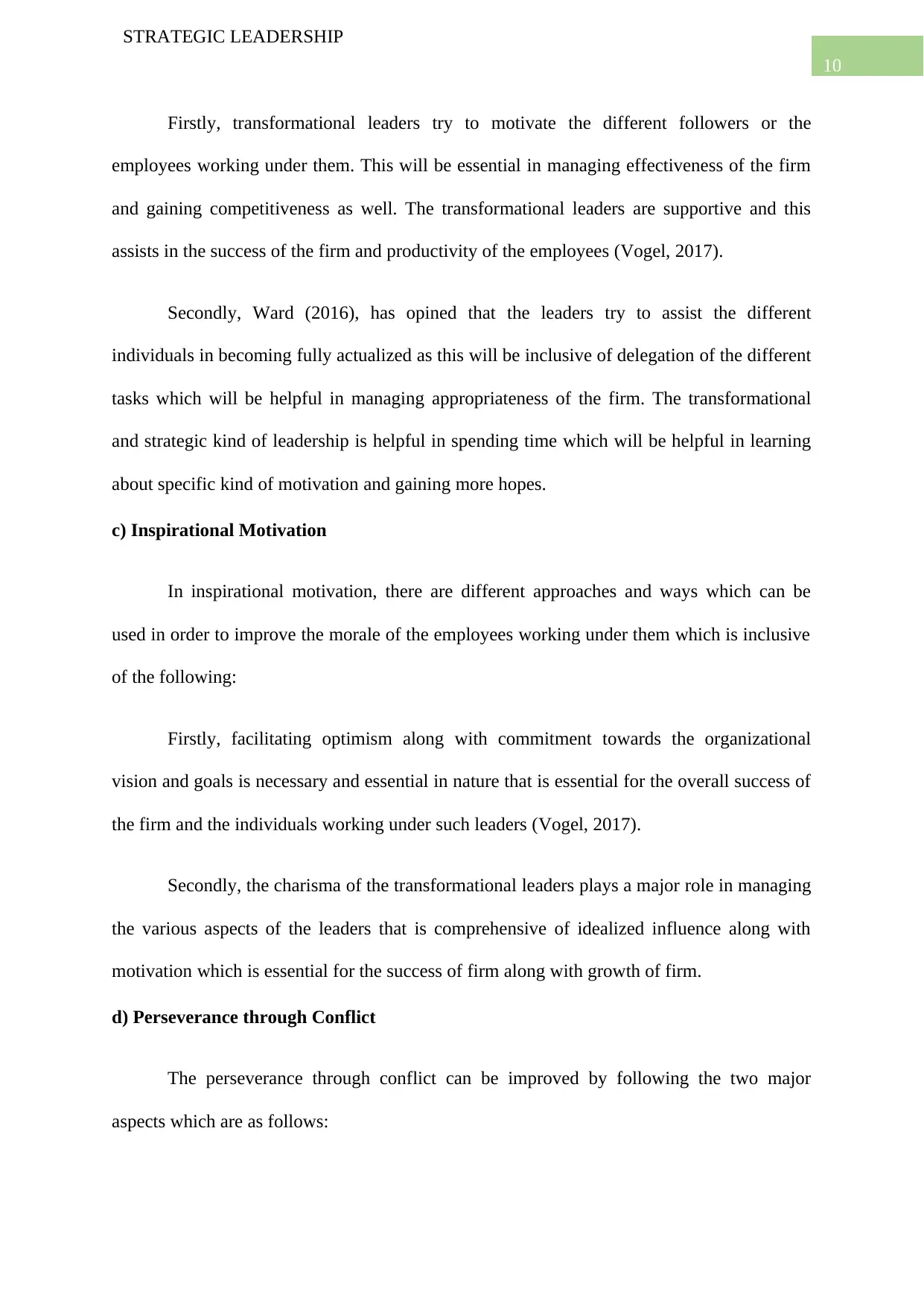
10
STRATEGIC LEADERSHIP
Firstly, transformational leaders try to motivate the different followers or the
employees working under them. This will be essential in managing effectiveness of the firm
and gaining competitiveness as well. The transformational leaders are supportive and this
assists in the success of the firm and productivity of the employees (Vogel, 2017).
Secondly, Ward (2016), has opined that the leaders try to assist the different
individuals in becoming fully actualized as this will be inclusive of delegation of the different
tasks which will be helpful in managing appropriateness of the firm. The transformational
and strategic kind of leadership is helpful in spending time which will be helpful in learning
about specific kind of motivation and gaining more hopes.
c) Inspirational Motivation
In inspirational motivation, there are different approaches and ways which can be
used in order to improve the morale of the employees working under them which is inclusive
of the following:
Firstly, facilitating optimism along with commitment towards the organizational
vision and goals is necessary and essential in nature that is essential for the overall success of
the firm and the individuals working under such leaders (Vogel, 2017).
Secondly, the charisma of the transformational leaders plays a major role in managing
the various aspects of the leaders that is comprehensive of idealized influence along with
motivation which is essential for the success of firm along with growth of firm.
d) Perseverance through Conflict
The perseverance through conflict can be improved by following the two major
aspects which are as follows:
STRATEGIC LEADERSHIP
Firstly, transformational leaders try to motivate the different followers or the
employees working under them. This will be essential in managing effectiveness of the firm
and gaining competitiveness as well. The transformational leaders are supportive and this
assists in the success of the firm and productivity of the employees (Vogel, 2017).
Secondly, Ward (2016), has opined that the leaders try to assist the different
individuals in becoming fully actualized as this will be inclusive of delegation of the different
tasks which will be helpful in managing appropriateness of the firm. The transformational
and strategic kind of leadership is helpful in spending time which will be helpful in learning
about specific kind of motivation and gaining more hopes.
c) Inspirational Motivation
In inspirational motivation, there are different approaches and ways which can be
used in order to improve the morale of the employees working under them which is inclusive
of the following:
Firstly, facilitating optimism along with commitment towards the organizational
vision and goals is necessary and essential in nature that is essential for the overall success of
the firm and the individuals working under such leaders (Vogel, 2017).
Secondly, the charisma of the transformational leaders plays a major role in managing
the various aspects of the leaders that is comprehensive of idealized influence along with
motivation which is essential for the success of firm along with growth of firm.
d) Perseverance through Conflict
The perseverance through conflict can be improved by following the two major
aspects which are as follows:
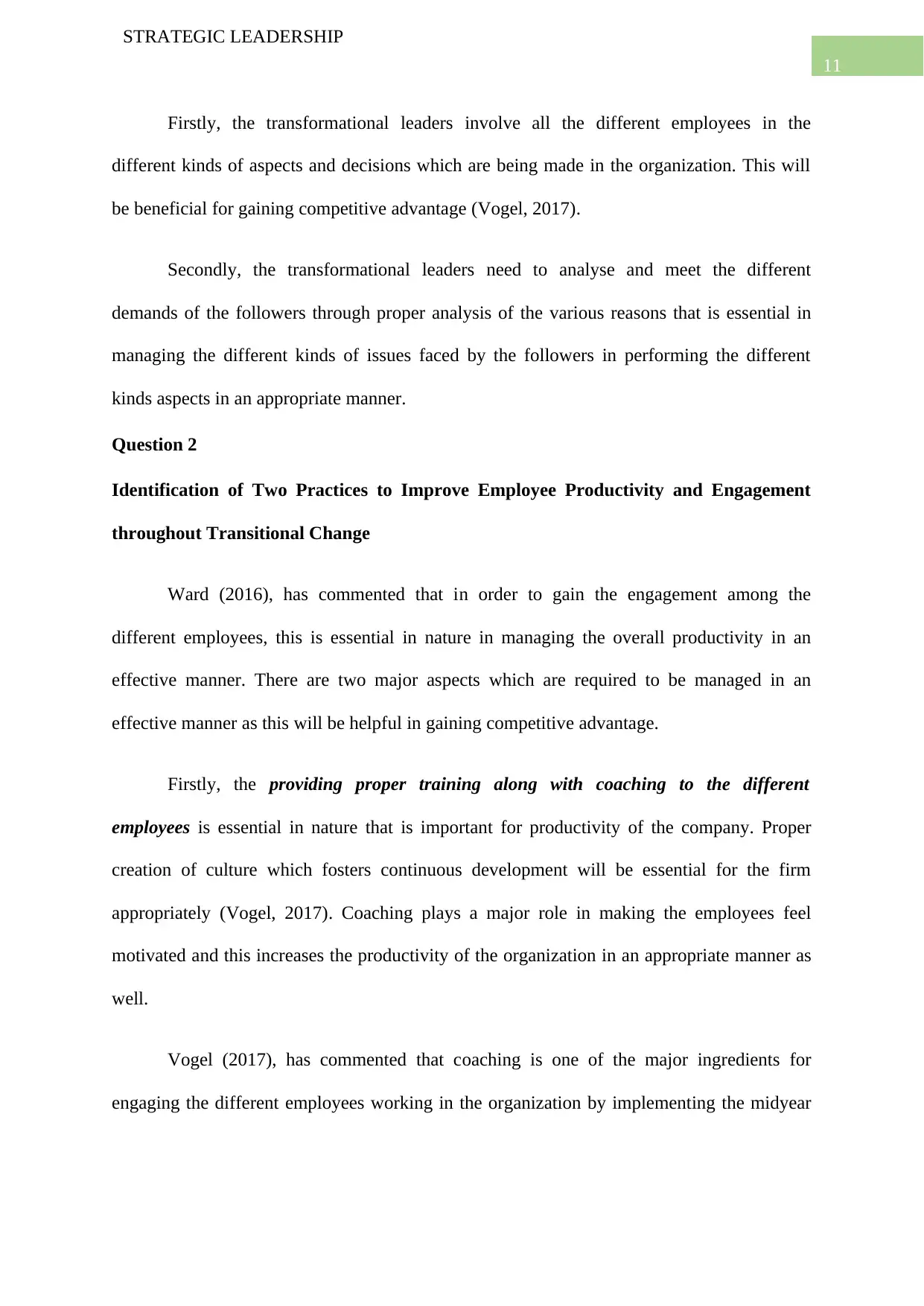
11
STRATEGIC LEADERSHIP
Firstly, the transformational leaders involve all the different employees in the
different kinds of aspects and decisions which are being made in the organization. This will
be beneficial for gaining competitive advantage (Vogel, 2017).
Secondly, the transformational leaders need to analyse and meet the different
demands of the followers through proper analysis of the various reasons that is essential in
managing the different kinds of issues faced by the followers in performing the different
kinds aspects in an appropriate manner.
Question 2
Identification of Two Practices to Improve Employee Productivity and Engagement
throughout Transitional Change
Ward (2016), has commented that in order to gain the engagement among the
different employees, this is essential in nature in managing the overall productivity in an
effective manner. There are two major aspects which are required to be managed in an
effective manner as this will be helpful in gaining competitive advantage.
Firstly, the providing proper training along with coaching to the different
employees is essential in nature that is important for productivity of the company. Proper
creation of culture which fosters continuous development will be essential for the firm
appropriately (Vogel, 2017). Coaching plays a major role in making the employees feel
motivated and this increases the productivity of the organization in an appropriate manner as
well.
Vogel (2017), has commented that coaching is one of the major ingredients for
engaging the different employees working in the organization by implementing the midyear
STRATEGIC LEADERSHIP
Firstly, the transformational leaders involve all the different employees in the
different kinds of aspects and decisions which are being made in the organization. This will
be beneficial for gaining competitive advantage (Vogel, 2017).
Secondly, the transformational leaders need to analyse and meet the different
demands of the followers through proper analysis of the various reasons that is essential in
managing the different kinds of issues faced by the followers in performing the different
kinds aspects in an appropriate manner.
Question 2
Identification of Two Practices to Improve Employee Productivity and Engagement
throughout Transitional Change
Ward (2016), has commented that in order to gain the engagement among the
different employees, this is essential in nature in managing the overall productivity in an
effective manner. There are two major aspects which are required to be managed in an
effective manner as this will be helpful in gaining competitive advantage.
Firstly, the providing proper training along with coaching to the different
employees is essential in nature that is important for productivity of the company. Proper
creation of culture which fosters continuous development will be essential for the firm
appropriately (Vogel, 2017). Coaching plays a major role in making the employees feel
motivated and this increases the productivity of the organization in an appropriate manner as
well.
Vogel (2017), has commented that coaching is one of the major ingredients for
engaging the different employees working in the organization by implementing the midyear
⊘ This is a preview!⊘
Do you want full access?
Subscribe today to unlock all pages.

Trusted by 1+ million students worldwide
1 out of 16
Related Documents
Your All-in-One AI-Powered Toolkit for Academic Success.
+13062052269
info@desklib.com
Available 24*7 on WhatsApp / Email
![[object Object]](/_next/static/media/star-bottom.7253800d.svg)
Unlock your academic potential
Copyright © 2020–2025 A2Z Services. All Rights Reserved. Developed and managed by ZUCOL.




